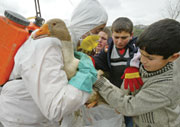Bird Flu Mutating!

I just got a disturbing e-mail from Dr. Kapustin from "Nature.com". It looks like Nature is way out in front as far as published information about the H5N1 virus. This latest publication states that the current virus flash point in Turkey shows two new mutations. The first is a switch in an amino acid change at the 223 position on the hemaglutination (H) protein. This increases it's affinity for binding to human cells and decreases it's affinity for bird cells. The second is another switch ,like the 223-haemoagglutinin mutation, it signals adaptation to humans, says Alan Hay, director of a WHO influenza laboratory at the NIMR. "There is this glutamic acid–lysine flip," he explains. "Glutamic acid is associated with flu-virus replication in birds, and lycine is in primates."These changes put us on the track to the 10 genetic changes associated with the 1918 pandemic. Dr. Tier spoke of a recent meeting where it was speculated that if we reach that point with this virus we can expect 300 million dead......thats 300,000,000 dead. The infection in Turkey( yes, that's technically Europe) seems to include alot of family clusters that could indicate human to human transmission , however, there is only a 20% mortality in this outbreak and as of now no data as to why it is behaving differently here. In another study from the Erasmus medical center in Rotterdam in the Netherlands found that the virus wreaks havoc in the brain, liver, kidney, heart and numerous other tissues, they find, killing cells and triggering inflammation. By contrast, the flu viruses that strike people in winter largely limit their damage to the nose and lungs. This discovery backs up earlier studies in mice and ferrets, and may help to explain why the bird flu kills so many of the humans it infects. "It's promiscuous," says veterinary pathologist Corrie Brown, who studies infectious diseases at the University of Georgia, Athens. "It doesn't care what type of cell it invades." It was also shown that the virus can be shed in urine and feces
from infected cats, a species previously thought to be immune.Researchers think that people mostly catch the disease by breathing in virus from contaminated bird droppings, but it has not been clear that it could spread between mammals by a faecal-oral route too. We need to keep a close eye on this one , while we may not see it this year or at all for that matter, it is still a frightening virus with the potential for world wide devastation.

Comments